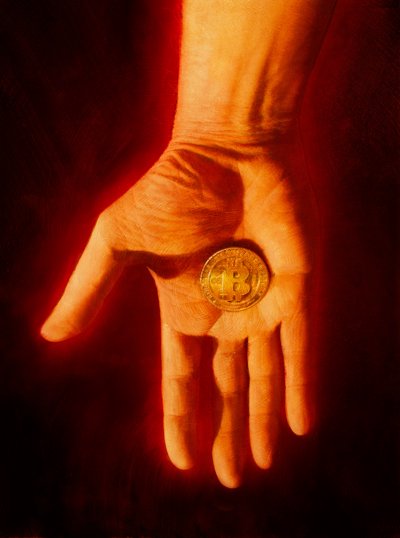The real magic of Bitcoin is the blockchain technology behind it that renders the illusion of value real.
The best stories always take a twist.
Take Bitcoin. The world’s first digital currency eased onto the scene in 2009 as quietly as a quarter hitting a carpeted floor.
Few besides tech geeks took note—at first—and the virtually worthless virtual money was virtually given away. In May 2010, in what’s widely recognized as the first real-world transaction with Bitcoin, a programmer named Laszlo Hanyecz paid 10,000 bitcoins for two pizzas.



But within four years bitcoins were trading above $1,100 each and the cryptocurrency had gained a wide range of loyalists—among them civil libertarians, technologists, futurists, Wall Street speculators, drug dealers and assassins.
So began an unlikely march to respectability for the controversial currency that wide price swings, fraud and bankruptcy never fully halted, and culminated last year in truly ironic fashion: the IRS deemed the outlier currency fit to tax.
More recently, Sen. Rand Paul followed Amazon, Subway, Dell, Expedia, WordPress, Virgin Galactic, PayPal and Microsoft in accepting bitcoins—and so became the first presidential candidate in U.S. history to raise cryptocurrency campaign funds.
Reasons for Bitcoin’s popularity are as diverse as those who embrace it.
Some like its anonymity—the ability to send and receive money minus the typical financial trail—and its weightless portability. Others applaud low transaction fees; like that bitcoins can be wired to anyone, anywhere via Internet or smartphone and sans banks; and believe it’s a better store of value than fiat currency. For others still, Bitcoin’s decentralized nature—in theory, no country or even blocs of countries can manipulate it—appeals to their iconoclastic leanings.
Bitcoin attempts the novel: to cut governments out of the money business—or a slice of it anyway—and in severing that tie create a more stable store of value, replacing nebulous ‘full faith and credit’ with hard math.
While cryptocurrency is fascinating, the fact is, Bitcoin is floundering. A peek at its transaction volume—how many bitcoins actually change hands daily—shows why: More than 70 percent of the roughly $3 billion in circulation sit stagnant, a deathblow for any budding medium of exchange. As for being a stable store of value, just after tax day in the spring of 2015, the currency’s worth was waning. A bitcoin traded at just over $239, down from $313.92 to start the year and roughly $500 in 2013.
The idea of an independent digital currency capable of being sent anywhere, anytime, to anyone for almost nothing is romantic. But the harsh flipside is that, with no central bank backing, its value plunges or soars unchecked.
Not helping confidence, is withering criticism from—among others—Nobel Prize-winning economist Paul Krugman. Krugman’s 2014 New York Times opinion piece bore the title “The Long Cryptocon” and followed his 2013 declaration in the same publication that “Bitcoin is Evil.”
No love, no problem. Which brings us to the twist.
It turns out Bitcoin might not be the star of its own story—that it’s the underpinning technology, known as the blockchain, that has the real revolutionary potential.
To understand the technological innovation that a strange alliance of interests—ranging from freedom of speech advocates to big business—hail as having power to transform commerce, democracy and culture rivaling that of the Internet itself, it’s necessary to trace a rather curious path.
In 2008—not coincidentally in the midst of a global financial meltdown—Satoshi Nakamoto, a pseudonymous cryptography buff whose real identity remains a mystery, published “Bitcoin: A Peer-to-Peer Electronic Cash System,” a paper describing a robust framework for a currency that could run without the backing of any government and eliminated the need for a trusted third party—banks.
In just nine pages, “Nakamoto” laid out Bitcoin and its underlying mechanics. Features included: defenses against double spending; no central issuing authority; and recordkeeping through a decentralized computing network organized using cryptography. Thus was crafted in one brilliant stroke a self-perpetuating currency ecosystem that created money, prevented fraud, transferred value, and bypassed financial institutions and issuing governments while creating and preserving accurate, auditable and permanent digital transaction records.
The open source coding—meaning no one owned it and anyone could use it—was perfect-ish. Even if there were some challenges, the system worked surprisingly well. Money would never be the same again.
There were obvious implications for business, and industry quickly came running. But it wasn’t Bitcoin they were chasing after—what piqued their interest was the built-in accounting protocol that made it go: blockchain technology, sometimes referred to as Bitcoin 2.0.
“I believe—and this is my personal view,” says Oliver Bussmann, chief information officer at Swiss bank UBS, “that block chain technology will not only change the way we do payments, but it will change the whole trading and settlement topic.”
The Bank of England has also called the blockchain—essentially a distributed, giant ledger that keeps track of who owns how much bitcoin—a “significant innovation” with potential “far-reaching implications.”
Bussmann believes the blockchain could initiate a “massive” simplification in banking and reduce associated costs. “When somebody with a strong brand and security level establishes it as a reliable service, then the whole industry will follow,” Bussmann says.
In May, the Nasdaq stock exchange announced it will adopt the blockchain starting later this year. “The creation of a securities distributed ledger function using blockchain technology will provide extensive integrity, audit ability, governance and transfer of ownership capabilities,” Nasdaq said in a statement.
“Blockchain is a natural digital evolution for managing physical securities,” says Nasdaq CEO Bob Greifeld. “Once you cut the apron strings of need for the physical, the opportunities we can envision blockchain providing stand to benefit not only our clients, but the broader global capital markets.”
And finance isn’t the only industry where the blockchain stands to create opportunity—the technology has a wide array of applications.
A movement is underway, for example, to use the blockchain to enhance civil liberties. “Follow My Vote Inc.” is a Virginia-based company that designs voting software that “blockchain technology [makes] virtually bulletproof,” according to the company’s website.
The California Association of Voting Officials (CAVO) is taking a close look at the blockchain, according to spokesman Brent Turner, who said several aspects of the technology are attractive.
“Our position is that any voting system should be publicly owned and not corporate owned software,” Turner says. “The fact that [the] blockchain is open-source, transparent and auditable makes it an attractive option—though more research and analysis needs to be done.”
Kammi Foote, past CAVO president and the current registrar of voters in California’s Inyo County, believes the blockchain might be the future of voting and is considering the technology for use in her jurisdiction. “It looks very promising,” she says. “We see potential for open-source to reduce costs and increase transparency in the voting process.”
Then there’s Devon Read.
The former combat Marine and Hollywood visual effects artist is using the blockchain in a very different way—to create an online library that he says would be “impossible to censor.”
Read’s company, Blockchain Technology Group of San Diego, is raising seed money to develop Alexandria: The People’s Library, an open-source, decentralized repository for sharing and preserving art, history and culture.
He believes the blockchain can preserve free speech while also monetizing web content—historically a vexing problem—by making micropayments feasible.
“Imagine a platform like Youtube, Soundcloud or Netflix without any costly server or bandwidth overhead,” Read says. “Artists can self-publish anything, including videos, music, books and 3D-printables and they would have complete control over how their work is published with several different monetization options.”
“What Bitcoin did for money, Alexandria will do for digital content publishing and distribution,” Read continues, “by removing central points of failure and financially incentivizing users around the world.”
Read is not alone in believing that the blockchain will redefine—well, everything.
To better grasp how this technology might bring about a sea change in many and varied applications, it helps to have a basic understanding of what it is and what it does.
The blockchain is a ‘sequential transactional database’ on which Bitcoin, its first application, relies entirely; it provides the currency’s credibility, value and disbursement. It does this in a way that is genuinely new. Instead of creditors relying on the solvency of the currency’s issuer, historically a national government, they rely instead on the blockchain itself to authenticate ownership and value.
The blockchain, in essence, is a giant ledger of Bitcoin transactions. It keeps track of who owns bitcoins today and is also a record of who has owned every bitcoin since the currency’s inception. The bitcoins themselves are not physical objects, or even digital files—they are entries in the ledger; owning bitcoin is having a claim on a piece of information that makes the blockchain. When units of the currency—bitcoins—are transferred from one party to another, a new “block“ of transactions is added to the existing chain—hence the name.
The transactions in these blocks don’t have to be approved by some central arbiter, as in conventional banking. Instead, entities known as ‘miners’ authenticate them using a consensus algorithm running across thousands of computers. In exchange, new batches of coins are released to the miners, pumping new currency into circulation and providing compensation for the data processing work. Rewards are high enough so that data centers across the world want the ‘mining’ work, so—unlike a bank ledger, which can be altered by its owner (or a government)—the blockchain cannot be changed without simultaneously overwriting all of the thousands of copies used by the miners at any one time.
Also unlike a bank’s ledger, the blockchain is public—anyone can download a copy. Identities are protected by cryptography; beyond that the system is entirely transparent.
This system of consensus by distributed cooperation is perpetually auditable and theoretically immune to catastrophic attack or single-point failure. It also allows for something of value to be transferred from one person to another without a middleman to verify the transaction—and charge related fees—which many believe could change the way money is borrowed, loaned out and priced.
A first impact could be on the way money is transferred around the world.
The global remittance market netted $46.3 billion in fees in 2014, an average of 7.75 percent per $200 transaction. The blockchain could virtually eliminate those fees, a boon for countries like India, the Philippines and Mexico, where the economy relies on expats sending money “home” and where yearly per capita incomes range from $1,570 to $9,940.
But it’s not just developing countries that could benefit from reduced fees. More than 70 percent of all U.S. transactions are cashless and involve a financial intermediary greasing the skids by taking on risk (in the case of credit card purchases) or in transferring sums (with debit transactions). Merchants typically pay between 1 and 3 percent per sale for this service.
What if that was free, too?
And how attractive would micropayments be if you could send $0.25 for a newspaper article—or to a farmer in Pakistan—without a transaction fee of $0.50?
Many believe that, beyond changing the institution-dominated shape of modern finance, the blockchain is a platform for myriad as-yet-unthought-of innovations.
The forward thinking that has been includes IBM’s ADEPT technology, a system developed with Samsung that’s using blockchain technology to foster the Internet of Things (IoT)—the concept of connecting any device with an on/off switch to the Internet and/or to one another. This includes everything from cell phones, coffee makers, washing machines, headphones, lamps, wearable devices—and also machine components, such as a jet engine or the drill of an oilrig. This giant network of connected “things” would create relationships between them and monitor their needs and interdependencies. For example, when you set your alarm for 6 a.m., your Keurig knows it and starts the coffee on time. And when you take the last brew pod from the storage drawer, it notifies Amazon to ship another pack of morning blend.
“In our vision of a decentralized IoT, the blockchain is the framework facilitating transaction processing and coordination among interacting devices. Each manages its own roles and behavior, resulting in an ‘Internet of Decentralized, Autonomous Things’—and thus the democratization of the digital world,” according to a recent IBM paper. “In this model … devices are the master.”
Wouldn’t that be a twist?
























